Brian Meert's Blog, page 109
August 20, 2018
How L’Oreal’s Partnership with Facebook Tempts My Beauty Budget
 August 20, 2018
August 20, 2018Anna Hubbel
How L’Oreal’s Partnership with Facebook Tempts My Beauty Budget. #ar #virtualrealilty #artechnology
Click To Tweet Haley Rivera / Unsplash
Haley Rivera / Unsplash
We’re no strangers to the Facebook and beauty market dynamic. In fact, I have purchased beauty products through the platform. Major beauty company L’Oreal is revolutionizing the way we shop for beauty products in its latest partnership with Facebook. The company will market products using augmented reality ads (AR), allowing shoppers to virtually sample makeup through the Facebook camera.
According to Mobile Marketer, the L’Oreal-Facebook partnership came shortly after L’Oreal adopted Modiface, an AR beauty tech startup. Modiface’s software allows shoppers to view a 3D image of their face in real time so they can see how products will look on them. For example, I could try different shades of lipstick or eyeshadow to help me decide what would look best with my complexion.
Previously, Modiface worked with 84 beauty brands to deliver AR experiences for showcasing cosmetics, says Mobile Marketer. This allowed numerous brands to offer virtual tutorials for their products. Now, Modiface will provide its technology exclusively to L’Oreal, which will propel the beauty company ahead of its competitors.
Although the use of AR to promote makeup isn’t new, the joint effort with Facebook can significantly boost L’Oreal’s engagement with shoppers. The social network has over two billion potential users the beauty company can reach. Additionally, Facebook offers customizable AR experiences through its boundless archives of user data reflecting interests, preferences, and spending habits. The social network’s advanced computer vision technology even makes it possible to analyze users’ photos to determine the best audiences to target.
L’Oreal’s NYX Professional Makeup line will debut on Facebook’s camera by the end of August, according to Mobile Marketer.
Why AR Makes Me Buy More

Online ads for cosmetics lack one major thing: the ability to try the products before buying. Oftentimes when I shop for beauty products, I experience buyer’s remorse before reaching checkout because there’s no guarantee that I’ll like how the product looks on me. But with AR technology, I’m able to model different color blushes, eyeshadows, and lipsticks, so when I get to checkout, I know exactly what I’m getting and how I’ll like it when it arrives.
When I shop at a clothing retail store like Kohl’s or JC Penny, one of the most exciting thrills for me is trying on different outfits in the dressing room. Just because something looks good on the hanger doesn’t mean it will look good on the live model. Coloring and shape need to be taken into account, which is why trying on the outfit is so helpful. With L’Oreal’s new AR partnership, you get the virtual dressing room for your face. You also don’t have to go anywhere. You can see what looks good while cleaning your room, taking a walk, or lying in bed.
AR makeup sampling will increase shoppers’ confidence and satisfaction with their purchases. The more satisfied I am with a makeup purchase, the more likely I am to return to the same brand for future beauty purchases. Therefore, AR also helps build brand loyalty. The more loyal customers a brand has, the better its reputation, which will help attract entirely new customers.
Advertising with AR
Last month, we learned that Facebook is testing AR ads for all kinds of products in News Feed. If the testing delivers successful results, brands beyond just the beauty industry will be advertising using AR. Facebook will become a virtual dressing and makeup room, a digital mirror. Advertisers will be able to convert more users into customers because there will be more confidence in purchase satisfaction.

Advertising is breaking new ground with technology like AR. AR gives shoppers like me more engaging shopping experiences from wherever we are so we can make purchases without any regret. When we invest in our appearance, we want to be sure we’re going to look good, and being able to do so from the convenience of our phones is a bonus. L’Oreal’s partnership with Facebook suggests a lot more to look forward to in terms of mobilized shopping.
I for one am excited to expand my eyeshadow color palette. But beauty is only the beginning.
Written by Anna Hubbel, staff writer at AdvertiseMint, Facebook advertising agency
The post How L’Oreal’s Partnership with Facebook Tempts My Beauty Budget appeared first on AdvertiseMint.
August 17, 2018
How to Use Responsive Search Ads to Give Your Audience More Information
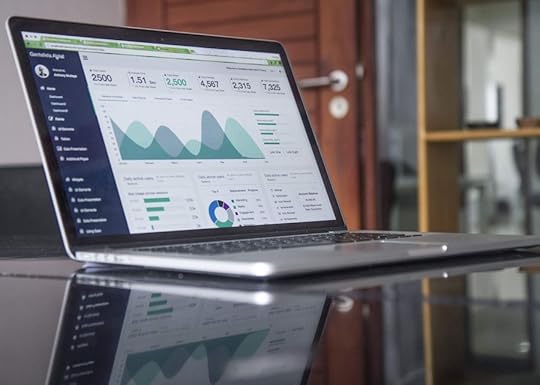 August 17, 2018
August 17, 2018Anna Hubbel
How to Use Responsive Search Ads to Give Your Audience More Information. #googleads #digitaladvertising #ppc
Click To Tweet

At Google Marketing Live back in July, Google introduced responsive search ads, which you can use to optimize your ad delivery for any relevant search entry. It’s accomplished using powerful machine learning capabilities. Start getting excited because Google says this new product is coming in September for English, French, German, and Spanish languages, with more to come soon.
What Are Responsive Search Ads?
Responsive search ads allow you to share more of your main message. You can create multiple headlines and descriptions when putting these ads together, which Google Ads will then test in various combinations to determine which delivers the best performance. This will improve your overall campaign because you will always end up with the optimal combination.
For example, if you own a clothing business, and you are running a special sale for camies, Google will use the headlines and descriptions you provide to determine which combination best matches what your audience searches for. The right combination will be used according to search queries to help optimize the results of your campaign. Using the magic of machine learning, Google is able to deliver various combinations without redundancy.
Responsive search ads are different from regular text ads in that they can show up to three headlines and up to two description fields containing a maximum of 90 characters. Additionally, regular text ads don’t test various combinations of headlines and descriptions.
Come late August, you can start adding a third headline and a second description to your existing text ads. You will also be able to include up to 90 characters in your ad descriptions.
What Are The Benefits?
Responsive search ads offer significant benefits. For one, they save you time that would otherwise be spent A/B testing. Google does the work for you. All you have to do is give it the text to work with. Second, they help you reach more people because even if one combination performs better than the others, the other combinations still appear to anyone whose searches closely match them. So your ad will always appear if at least one combination matches up with a search query.
Finally, responsive search ads help you increase ad group performance because they help you compete in more auctions. They attract more clicks and conversions than regular text ads.
Things to Keep in Mind When Creating Responsive Search Ads
Although the format does a lot of the work for you, you are still responsible for coming up with the text for your responsive search ads. Google suggests a few things to keep in mind when brainstorming text.
Include primary keywords in your headlines. You should have at least one in each headline you create. This will help Google match search queries.
Make each headline distinct. In other words, make each headline different enough from the others so Google has more combination options.
Highlight offers or benefits. For example, if you offer free returns, include that in your text somewhere.
Create headlines in various lengths. Don’t try to make each reach the maximum character limit.
Make the first three headlines read as they would if they were to appear together in the ad.
Try different call-to-actions in your headlines.
As you continue to explore this new format, which will be available in September, you’ll start to identify the combinations that perform the best and will therefore continue to optimize and provide Google with the best possible combinations to work with to make your campaign the best it can be.
New Google Ads
Last month, Google AdWords rebranded as Google Ads. While the new name includes all of the same advertising capabilities of its former self, it also introduced new brands and solutions to make Google Marketing Platform and Google Ad Manager. The former combines the capabilities of DoubleClick and Google Analytics 360 Suite to make a whole new marketing product while the latter unites DoubleClick for Publishers with DoubleClick Ad Exchange to simplify ad management. Changes like these demonstrate how the company is rejuvenating its ad offerings to give you the best possible advertising experience through the Google platform.
It’s an exciting time to advertise with Google. Start contemplating how you want to enjoy this time as September quickly approaches because this is just the beginning.
Written by Anna Hubbel, staff writer at AdvertiseMint, company for Facebook ads
The post How to Use Responsive Search Ads to Give Your Audience More Information appeared first on AdvertiseMint.
August 16, 2018
How Facebook’s New Page Authorization Requirements Affect You
 August 16, 2018
August 16, 2018Anna Hubbel
How Facebook’s New Page Authorization Requirements Affect You. #facebookads #facebook #business
Click To Tweet

Your page is your ticket to Facebook advertising because without it, you can’t advertise on Facebook. That’s why it’s especially important to adhere to Facebook’s latest page authorization requirements. Last week, the social media company announced that pages with large US audiences are now required to undergo new page publishing authorization. Additionally, the company is rolling out a feature that shows pages’ primary country location and page-merge information.
“Our goal is to prevent organizations and individuals from creating accounts that mislead people about who they are or what they’re doing,” Facebook said in its article about the updates. “These updates are part of our continued efforts to increase authenticity and transparency of Pages on our platform.”
Page Authorization
A fake Facebook page can do damage if it has a large US audience. Facebook learned that the hard way. In 2016, the company faced such a debacle when Russian troll accounts delivered politically divisive ads during the last US Presidential Election. The malicious activity stoked discord between people from two sides of the political spectrum, going so far as to cause real-world effects, such as organizing fake protests in US soil that people, unaware that the event was created by a fake page from Russia, attended. The activity went unnoticed until much later, by which time the damage had already been done. Facebook can’t be blamed for taking extra precautions to prevent such a scandal from happening again.
The new authorization process will make it more challenging for people to create fake Facebook pages. If you have a large US audience and wish to continue posting on your page, you will need to complete Facebook’s new authorization process. If Facebook requires you to complete the authorization process, you will receive a notice at the top of your News Feed. The process only takes a few minutes, requiring you to complete two-factor authentication and to confirm your primary country location.
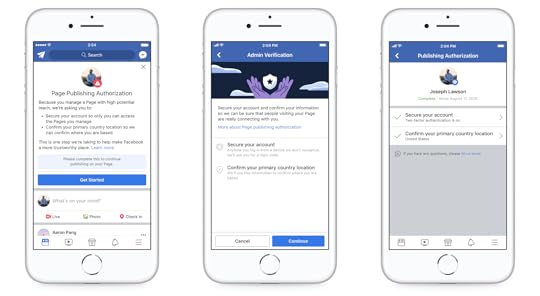 Image Courtesy of Facebook Business
Image Courtesy of Facebook BusinessWhat happens if you fail to complete the authorization process? According to Facebook, you will be unable to publish any posts from your page. If you continue to disregard Facebook’s new authorization process, the company will delete your page or your account. If you’re required to complete the process, do so immediately to continue posting and advertising on the platform. It’s better safe than sorry.
More Page Information
Facebook wants users to experience full transparency on its platform. To do that, pages must have pertinent information easily available for users about the businesses they represent. From now on, in the Info and Ads section of every page, users will be able to see information about any page mergers under the Page History section. The page merger information lets users know whether a page is or was at any point merged with another page. This information ensures users know the relationship of one page with another. As a result, fake accounts appearing as a completely new page while sharing information identical to its other, similar page will be unable to hide it.
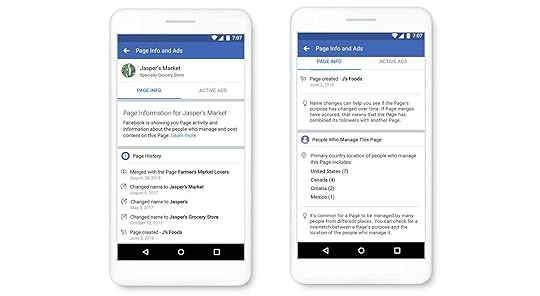 Image Courtesy of Facebook Business
Image Courtesy of Facebook BusinessAdditionally, Facebook is adding a new tab called People Who Manage This Page that will provide information about primary country locations from where you manage your page. Users didn’t know that the ads from the fake accounts were coming from Russia when they viewed them. Only Facebook knew that information. Now, everyone will be able to see that information so they know which country the ads and posts originated. The new tab will initially appear on pages with sizeable US audiences. You should expect to see it on all pages sometime in the future.
Expanding to Instagram
If you also have an Instagram account for your business, expect similar features in the coming weeks, particularly if your account has a large US following.
Even though Instagram wasn’t used maliciously during the US election and even though Instagram maintains a pristine reputation, you can understand why the company would be cautious, implementing similar updates to both platforms. With Instagram’s growing popularity, it could easily fall into the same sense of complacency that Facebook did. The company clearly recognizes this possibility and does what it can to be consistent in its measures for both Facebook and Instagram.
As long as you follow Facebook’s rules, your Facebook pages will remain untouched. Facebook and Instagram are still two of the most popular social media platforms. Don’t give up on them simply because Facebook enforced a few more ordinances to keep the platform an honest and transparent space, such as introducing new restrictions for ads promoting addiction treatment centers and bail bonds and signing a legal agreement that prevents the exclusion of protected groups in housing ads (e.g. ethnic and religious minorities, immigrants, etc.).
Facebook users demand honesty and transparency. If given what they want, they will remain active users on the company’s platform—that bodes well for your business.
Written by Anna Hubbel, staff writer at AdvertiseMint, Facebook advertising company
The post How Facebook’s New Page Authorization Requirements Affect You appeared first on AdvertiseMint.
August 15, 2018
Facebook Has New Restrictions for Addiction Treatment Center and Bail Bond Ads
 August 16, 2018
August 16, 2018Anna Hubbel
Facebook Has New Restrictions for Addiction Treatment Center and Bail Bond Ads. #facebookads #facebookadvertising #news
Click To Tweet

Facebook recently announced new restrictions for two types of ads, ads for addiction treatment centers and ads for bail bonds. From now on, addiction treatment centers must first be precertified to advertise in the US, and ads promoting bail bonds are now prohibited. These new restrictions apply to ads across Facebook, Instagram, Messenger, and Audience Network.
Why is Facebook suddenly implementing these new restrictions? According to its announcement, the company explained it found that various ads in those two categories fall short of the platform’s standards of quality. The serious implications surrounding each category suggest that the promotion of related services should be dealt with a cautious and strict hand to prevent any negative experiences for Facebook users.
“People facing addiction or who have loved ones in need should be able to find support without encountering scams or predatory behavior,” the company states in a Facebook Business article. The new restrictions will prevent advertisers from crossing that line.
Precertification for Addiction Treatment Center Ads
To prevent addiction treatment centers that don’t meet basic healthcare quality standards from reaching users with addiction struggles, Facebook now requires centers to obtain certification from Legit Script. Once the third-party certification service reviews the applicant’s qualifications and approves, the center must then apply to advertise to US users on Facebook. Facebook will then review the center’s application to determine whether it should be allowed to advertise.
The new precertification requirement, according to Facebook, prevents underqualified centers from taking advantage of people struggling with drug and alcohol addiction.
“Many of these [centers] take part in insurance scams and many keep people in a cycle of addiction with unproven treatment methods,” explains the Facebook Business article.
This update will hopefully keep users safe from malicious scams and help them along their road to recovery.
No More Ads for Bail Bonds
When a loved one is arrested, friends or family are more vulnerable to bail bond offers that leave them swimming in debt. Facebook considers this exploitation highly unethical and unacceptable. With the new ban of ads promoting bail bonds, Facebook is expanding its restrictions for money-related products and services such as payday loans. Since these types of products can get complicated, some businesses manipulate them and try to trick vulnerable users into buying them. Facebook wants to prevent its platform from being used to spread this manipulative practice.
“We consulted a wide range of policy experts, advocates, and community organizations working in criminal justice to ensure we’re taking the right approach,” Facebook says in the article.
More Restrictions, Better Experiences
You know the saying We do what we do because we love you. Facebook has been implementing more restrictions and review processes for advertisers and developers to ensure users can have better platform experiences. For example, back in July, Facebook announced new API restrictions for products like Graph API Explorer, Media Solutions, Pages API, and Marketing API to help users feel safer when using apps through the platform. Facebook also recently restricted weapon accessory ads to a minimum age of 18 for audience targeting. Changes like these ensure that users who want to see your ads are seeing them and those who don’t want to see them are not required to. If users have better experiences, they will be more engaged with your ads and products. Although it may require more steps in the process, your ads will do better with these new restrictions in place.
Facebook has cracked down on its advertising policies and privacy capabilities ever since the Cambridge Analytica scandal and the misuse performed by Russian troll accounts during the 2016 US Presidential Election. Users began to question whether Facebook really had their best interests at heart. But Facebook responded full blast, immediately making it easier for users to access their privacy controls, informing them whether their data was harvested in the scandal, and improving transparency for all ads and Facebook pages, among many other changes. The latest updates for addiction treatment centers and bail bonds are just one more chip in the block.
All of these changes may feel threatening to you as an advertiser, but if you’re an honest and ethical business, you can trust that Facebook is looking out for you and will continue to find ways to make it easier for advertisers and the average user to coexist. The company recognizes the integral role its platform plays in digital marketing strategies across the globe. It’s not about to abandon its advertising following. If you’re unsure whether your business adheres to Facebook’s policies, read about the 13 types of businesses that can’t advertise on Facebook.
Facebook wants everyone to benefit from its platform, including advertisers and developers. The new restrictions are not meant to be a punishment. They’re simply intended to help everyone have a better experience on the platform.
The post Facebook Has New Restrictions for Addiction Treatment Center and Bail Bond Ads appeared first on AdvertiseMint.
August 14, 2018
Is Facebook Considered a Mobile Browser? Research Says Yes
 August 14, 2018
August 14, 2018Anna Hubbel
Is Facebook Considered a Mobile Browser? Research Says Yes. #facebook #socialmedia #internet
Click To Tweet Tim Bennet / Unsplash
Tim Bennet / Unsplash
Chrome and Internet Explorer are the two big names we typically think of when talking web browsers, and that’s no surprise, considering they are the leading browsers in the US. However, you may not realize that there’s another platform rising as a widely used browser for mobile: Facebook.
A recent Tech Crunch article reports that data by analytics provider Mixpanel shows Facebook has become a major player as a US mobile browser. In fact, in most states, Facebook emerged with an average market share in mobile browsing of 8.82 percent. Apple’s Safari makes up an average share of 58.06 percent and Google Chrome an average of 32.48 percent. The leftover 0.64 percent goes to all other browsers.
States’ Use of Facebook As a Mobile Browser
Below is a list of US states that use Facebook as a mobile browser, as reported by Tech Crunch. These percentages reflect the amount people use Facebook to search for content related to news, entertainment, etc., on their mobile devices.
Washington (13.74%)
Rhode Island (13.14%)
Montana (12.64%)
Texas (10.12%)
Hawaii (10.94%)
New Hampshire (10.52%)
Indiana (11.93%)
Missouri (11.49%)
Pennsylvania (10.92%)
South Carolina (10.16%)
North Carolina (11.8%)
Oregon (9.73%)
North Dakota (9.9%)
West Virginia (9.95%)
Minnesota (11.81%)
Delaware (9.94%)
Facebook and Mobile Content

Of course, Chrome and Internet Explorer still maintain their places as the most widely used internet browser. Yet, it is still amazing to see people use Facebook’s search feature so often that the platform is considered a mobile browser. Once upon a time, it never would have even occurred to anyone to search for queries on Facebook.
Because Facebook was never intended to be a web browser, it’s no surprise that fake news spiraled out of control on the platform. The primary focus of the platform has always been to foster online relationships and share experiences by prioritizing popular and relevant content. Thus, its News Feed algorithm would not penalize publishers sharing viral fake news or clickbait content, which spiraled out of control during the 2016 US Presidential Election when Russian troll accounts distributed politically divisive ads. Facebook has since taken massive strides to stop this type of activity by working with publishers, distributing two-question surveys, and reducing news sources on News Feed.
Perhaps Facebook’s overall strategy will continue to adapt as it recognizes its power as a mobile browser. By doing so, it may be better able to ward off fake news and prevent global crises from occurring through the platform.
How Can You Use Facebook’s Search Tool?
There are a variety of different items you can search for using Facebook’s search bar. Below is a list of just a few things you can search for.
Pages
People
Businesses
Brands
Non-profit organizations
Restaurants
Keywords (e.g., beauty, New York, comedy, etc.)
Groups
Videos
Content your friends have shared
Photos you’ve seen
Apps
Events
Articles
Hashtags
Locations
Let’s say you’re interested in attending a Taylor Swift concert, for example. If you search for “Taylor Swift” and select the Events tab, you’ll see results for all Swift-related events that you can then browse through and mark as “Interested.” If you want to know where she’s headed next on her Reputation tour, you’ll see a list of every event for each different location.

Business Benefits of Facebook’s Browsing Reputation
In addition to the various perks you already get by advertising on Facebook and posting organic content through your business’s page, you also reap the benefits of the platform as a mobile browser. The more popular and relevant your page or brand, the higher you will appear in users’ search results. The higher you appear in Facebook’s search results, the better your reputation will be and the more likely users will choose your business to satisfy their needs. Since users primarily use Facebook as a browser on their mobile devices, your business’s exposure in search results reaches them wherever they are. All of this, and you don’t even have to pay for it. All you have to do is produce quality content and reputable customer service.
Facebook as a browser also helps drive foot traffic to your business’s physical location. Users often search for places on the platform to find an address. Even if someone searches for a location other than yours, they may still come across it in their search and decide to check you out. Restaurants and other location-driven businesses especially can benefit from this advantage.
You can use Facebook’s growing reputation as a mobile browser to boost your own reputation as a business. Taylor Swift isn’t the only one who can attract a big crowd! (Although her stage presence may give you a run for your money.)
Written by Anna Hubbel, staff writer at AdvertiseMint, Facebook advertising agency
The post Is Facebook Considered a Mobile Browser? Research Says Yes appeared first on AdvertiseMint.
Speak! Snapchat’s Voice-Activated Lenses Can Hear You
 August 14, 2018
August 14, 2018Anna Hubbel
 Jason Rosewell / Unsplash
Jason Rosewell / UnsplashAs voice assistants continue to rise in popularity, social media platforms are catching on. Snapchat recently launched new augmented reality (AR) Lenses that respond to your voice, according to The Verge. Similar to saying “Alexa” to activate the Amazon Echo or “Ok Google” to activate Google Assistant, these Lenses require activation words such as “hi” or “wow” to animate.
Some of us may find this new Lens feature very useful while others may prefer the literal hands-on approach. Here are some reasons why you may or may not enjoy Snapchat’s new voice-activated Lenses.
Why You May Enjoy Voice-Activated Lenses

The Snapchat app sometimes malfunctions when I try to select a Lens with my finger. Whether the issue is my phone’s screen or the app, being unable to use the Lens becomes frustrating. If you also experienced this struggle, you will enjoy the voice-activated Lenses. As long as the word is simple, like “okay” or “use,” this new capability can be very useful.
Voice-activated Lenses are also useful if you want to hold your phone with both hands. Balancing your phone in one hand while touching the screen with the other may fill you with anxiety: you would hate to drop your phone and crack your expensive iPhone’s screen. If you’re worried about your phone’s safety, then the voice-activation feature will certainly come in handy for you.
You will also likely love the voice-activated Lenses if you’re already accustomed to using voice assistants. You may already be used to giving voice commands to Alexa or Google to find out tomorrow’s weather forecast, set a timer, or learn how to spell “Supercalifragilisticexpialidocious.” If this is the case, using your voice to animate Lenses will be a seamless, comfortable, and familiar experience.
Voice-activated Lenses aren’t for everyone, of course. If the above reasons to enjoy them don’t apply to you, read on.
Why You May Not Enjoy Voice-Activated Lenses

I don’t typically like to draw attention to myself when taking a Snap. Because I’m self-conscious, I often want to capture the moment inconspicuously. For this reason, I would not want to regularly use Snapchat’s voice-activated Lense, especially in public. Drawing attention to myself while taking a Snap causes me to stiffen and act awkwardly in front of the camera. If I were taking a cute selfie while out for a walk, I would smile less genuinely for the camera if I noticed people staring at me as I posed for the picture.
Additionally, voice activation may disrupt a quiet scene I want to capture. For example, if I wanted to add a Lense to an alley cat I spotted downtown, using my voice to activate one of the Lenses may startle the cat and cause it to scamper away.
Whether or not you enjoy using Snapchat’s new voice-activated Lenses is a personal preference. Admittedly, however, there are potential benefits for marketers that like to use the platform.
Marketing Benefits of Voice-Activated Lenses

You will be able to combine compelling visuals with engaging sound when creating Sponsored Lenses. This capability encourages users to interact with your Lens, increasing their memory retention of your brand or message. It also allows you to create something unique to generate interest.
Additionally, although the words that can currently be used to trigger Lens animation are very simplistic, there’s the possibility of further enhancements. For example, Snap may eventually expand the feature to include phrases rather than just one-worded triggers. There is also the possibility that Snap will incorporate a voice assistant within its app, allowing users to search for anything related to your brand by using their voice.
Voice has become a factor of interest in social media marketing. Back in March, for example, code was discovered that forecasted voice calling for Instagram Direct. It’s not surprising that voice is a preoccupation for marketers since it opens a new type of advertising. Data has shown that certain factors will influence voice assistant owners to listen to ads. Primary factors include personalization (i.e. ads customized for each individual owner) and the ability to choose whether or not to listen to an ad. Snapchat exploring voice options for its Lenses is perfectly viable; it’s just getting its feet wet.
Do You Say “Snapchat” or “Instagram”?
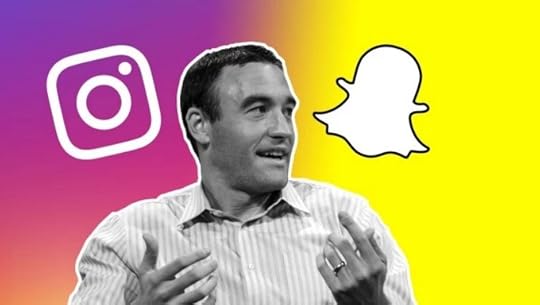 Photo Courtesy of TechCrunch
Photo Courtesy of TechCrunchSince Snapchat and Instagram are both exploring voice commands in their apps, we can surely expect more to come. They already compete in every other way: IGTV versus Snapchat Discover, Instagram Stories versus Snapchat Stories, and Instagram Location Stickers versus Snapchat Nearby Businesses Geofilter. Which will do it better? The answer may primarily rely on platform preference, or it may come down to user-friendliness. Most likely, however, it will all depend on which platform can most quickly and effectively answer the following question: can you hear me now?
Written by Anna Hubbel, staff writer at AdvertiseMint, company for Facebook ads
The post Speak! Snapchat’s Voice-Activated Lenses Can Hear You appeared first on AdvertiseMint.
August 13, 2018
3 New Ways to Reach Hardcore Gamers Like Me
 August 13, 2018
August 13, 2018Anna Hubbel

It takes a lot to get me to download a gaming app and play it on a regular basis. It takes even more to get me to make purchases within the app. But I know a good game when I see it, and when that rare moment does occur, I’m hardcore hooked.
Gaming marketers have a tough job reaching players like me. To change this, Facebook recently introduced three new ad solutions designed to easily overcome that challenge. The three solutions, created to reach players most likely to play and invest in your app, are
Playable ads
Retention optimization
Minimum return on ad spend (ROAS) bidding
Playable Ads
Playable ads, which you can use by choosing the app install objective, is the solution that appeals to me the most because it allows me to test a game before deciding whether I want to buy it. This removes the possibility of buyer’s remorse. When I pay for a game, I want a guarantee that I’ll enjoy it. Payable ads make that possible because I can try the game to see if it’s something I want to play again and again.
Playable ads help marketers drive higher-intent installs because gamers who tested the game are more likely to play after they’ve installed it. According to Facebook, game developer Bagelcode saw a 3.2 times improvement in return on ad spend for Android and a 1.4 times improvement for iOS after testing playable ads. Game developer Rovio also tested the ads and saw a 40 percent lower cost per paying user and a 70 percent lift in return on ad spend by day seven.
Retention Optimization

If you’re like me, you have very specific types of games that keep you engaged. For example, I tend to enjoy quiz show games and fantasy adventures. To help marketers reach players who are most likely to engage with their game, Facebook introduced its retention optimization solution, which delivers ads to the right audience, specifically, an audience that is most likely to play your game.
Currently, this new solution is being tested by Bitmango and Beijing Fotoable. Beijing Fotoable has already seen results, with a 30 percent higher return on ad spend as opposed to optimizing for installs.
“Facebook’s retention optimization solution has significantly improved our day 2 and day 7 retention rate,” Fotoable’s Chief Operating Officer Zijing Yan says in a Facebook Business article. “We saw a 30% better ROI compared to install optimization when looking at cost-per-day-7 retained user.”
From a gamer’s perspective, I like when a specific app speaks to my gaming preferences. If I see an ad for a quiz show or fantasy adventure game, I’m more likely to engage with it. Using retention optimization makes it possible for the developers of these games to deliver those ads to gamers like me.
If you have an ad-based revenue model, you are most likely to see results using retention optimization. Facebook will roll out retention optimization on Facebook, Instagram, and Audience Network later this year.
Minimum ROAS Bidding
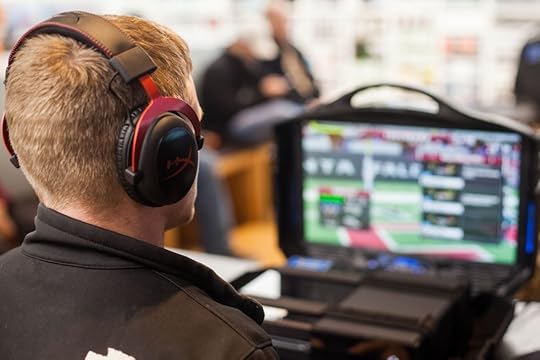
If it’s difficult to get me to download a game, it’s even more challenging to get me to make in-app purchases. Therefore, some developers may find my business less valuable compared to other gamers who make more in-app purchases. According to Facebook, an AppsFlyer study of US gamers found an average spend of $20 on in-app purchases by day seven and up to $49.33 by day 90. When you find the right audience for your app, these gamers, who are willing to make in-app purchases, are the most valuable.
Previously, you may have been familiar with Facebook’s value optimization tool, which helps you identify gamers with high purchase intent. The new minimum ROAS bidding solution makes that tool more effective because it allows you to set a minimum spend to reach those valuable gamers. It also frees you from unnecessary costs when trying to engage with gamers unlikely to make in-app purchases.
“Being able to set a minimum ROAS is critical for us to ensure we’re spending each of our clients’ dollars efficiently towards users who drive the most value as defined by their business, without sacrificing upside performance,” Manuel Pacreau, Addict Mobile’s head of operations, says in the Facebook article.
Minimum ROAS bidding will roll out on Facebook, Instagram, and Audience Network in September.
Game On
Some gamers are up for trying any new game. Sometimes, they prefer games that offer rewards. Others, like me, are very particular about the games they enjoy. But in all cases, there’s something out there for everyone. If we fit your app’s demographic, it’s up to you to make sure we know about your game. Facebook’s new ad solutions will help you do that. However, that’s not to say we won’t give you a run for your money. We are gamers after all, which means we enjoy a challenge.
Bring it on!
Written by Anna Hubbel, staff writer at AdvertiseMint, Facebook ad agency
The post 3 New Ways to Reach Hardcore Gamers Like Me appeared first on AdvertiseMint.
How Facebook Improves Relationships between Customers and Local Businesses
 August 13, 2018
August 13, 2018Anna Hubbel
How Facebook Improves Relationships between Customers and Local Businesses. #facebook #apps #localbusinesses
Click To Tweet

The Internet is a big competitive place for a small business. Fortunately, Facebook offers a way for small business owners to put their business out there and connect with potential customers in that vast, intimidating space. Whether it’s through an organic video post or an engaging ad, the platform makes it possible for small businesses to expand their reach and establish relationships with tech-savvy customers.
Although Facebook already connects more than 1.6 billion people to local businesses, the platform evidently determined that it could do more to help. Earlier this week, Facebook announced easier ways for you to connect your small business to potential customers. These updates will improve your ability to build a loyal customer base within the infinite audience that is the Internet.
Redesigned Pages for Mobile
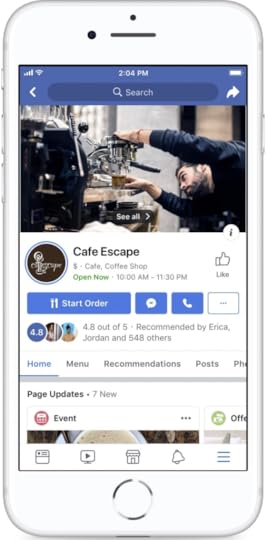
Facebook redesigned pages on mobile so customers can more easily communicate and engage with your local business. For example, if you have a page for your restaurant, customers can make a reservation from your page. Similarly, if you own a salon, visitors can book an appointment straight from your page on Facebook.
Additionally, the new design allows visitors to see Stories, recent photos, upcoming events, and offers on your page. With the new Stories element, you can share fun, behind-the-scenes content that is interesting to visitors, making your business more relatable. You can also make your business more relatable thanks to the recent photos feature. With the upcoming Events feature in the new design, you can increase the number of people attending your event. And of course, the new design highlights special offers you want to promote, which can help increase foot traffic to your brick-and-mortar store.
A user-friendly mobile design for a Facebook page is extremely instrumental in driving foot traffic to local businesses because most Facebook users access business pages through the app, whether they’re at home or on the go. The easier for customers to access information, the more likely they are to build a relationship with your business.
More Helpful Recommendations

Customers often visit business pages to read recommendations. Recognizing this fact, Facebook’s redesigned pages to make recommendations more prominent.
In addition to making recommendations easier to find so customers can review your business, the new design makes your business look more transparent. People trust the reviews of customers because they know they’re going to be honest about their experiences. With recommendations placed in a more prominent place, customers are determining that you aren’t afraid of what people say about your business. And unlike reviews, which contain both positive and negative opinions, recommendations only include praises. After all, no one makes a negative recommendation. People often recommend businesses they are pleased with.
Improving Events

Facebook’s Events feature increases in popularity, with 700 million users using it monthly to look for local activities. Facebook improved Events to help businesses and organizations encourage customers to attend local events. For example, customers can easily buy tickets to an event you’re hosting. Although Facebook is not a ticketing platform like Ticketmaster, according to Facebook, businesses sell twice as many tickets through the Events feature than through a website.
Events is a great way to connect with people in your community and to drive foot traffic to your brick-and-mortar store. If you own a dance club hosting a 90s-themed dance night, for example, sharing the event on Facebook helps spread the word and drive foot traffic to your location. If people have a good time at your event, they will likely return to your location in the future—they may even recommend your business to their Facebook friends.
Expanding the Job Application Tool
Employees play a significant role in making local businesses successful. Without them, your business can’t exist. After all, you can’t run a business on your own. You need people to whom you can delegate tasks. To help small local businesses grow, Facebook opened the Job Application Tool to a global audience, helping small businesses hire exceptional employees.
A “Local” Section
Gone are the days of Googling “places to eat near me.” Facebook now has a Local section people can use to find businesses, like yours, nearby. There’s also a standalone Facebook Local app for the same purpose. Users can browse places based on location, recommendations, or events friends are attending.
If you want to increase your foot traffic and appear higher in the Local section, you should focus on encouraging existing, happy customers to leave recommendations on your Facebook page. You should also consider hosting fun events to generate interest and acquire attendees who are likely to recommend your events to their friends.
Small Business Meets Big World
Don’t let the word “small” keep you from dreaming big. Over 80 million small businesses use Facebook’s free resources to connect and thrive in the vast world of the Internet. “Online” should not have a negative or unattainable connotation. In fact, most people who own a mobile device use it to find local businesses, and Facebook is continuously exploring new ways for small businesses like yours to succeed. It’s up to you to decide whether or not to use them.
Written by Anna Hubbel, staff writer at AdvertiseMint, Facebook advertising company
The post How Facebook Improves Relationships between Customers and Local Businesses appeared first on AdvertiseMint.
August 9, 2018
Use Facebook’s Info and Ads Feature to Improve Ad Campaigns
 August 9, 2018
August 9, 2018Anna Hubbel
Use Facebook's Info and Ads Feature to Improve Ad Campaigns. #facebook #digitaladvertising #business
Click To Tweet

Facebook rolled out the new Info and Ads feature at the end of June to allow users to view all active ads businesses or a company for Facebook ads run across any Facebook-owned platform, including Instagram. Facebook created the feature to improve transparency across its services so users can better trust the platform and have positive experiences.
Transparency became Facebook’s priority after the news broke that Russian troll accounts distributed politically divisive ads during the 2016 US presidential election to provoke voters. As if this discovery didn’t cause enough concern, the public also learned that data firm Cambridge Analytica harvested personal information from over 80 million Facebook profiles through an app to deliver manipulated messages for the 2016 Trump campaign. To earn the people’s trust, Facebook has taken action in various ways, such as implementing stricter rules for advertisers and app developers. Additionally, the company introduced new tools, such as the Info and Ads feature.
If you own a business, you may be wary about the Info and Ads feature because the information about all of your Facebook ads is available for anyone to see. Users, even those you didn’t target for your ads, aren’t the only ones who can see your strategies. Rivals, too, will be able to identify your advertising patterns: the targeting, format, copies, and creatives you use. The secrets to your success will be available for all to see.
Before you toss in the towel, you should know that you can use the Info and Ads feature to your benefit. With this level of transparency, not only does Facebook become more trustworthy but also your business. Users feel more comfortable with your business knowing you have nothing to hide, knowing that your practices are ethical and within the bounds of Facebook’s advertising policies.
But there’s more. The Info and Ads feature can also provide significant insight you can use for marketing research and benchmarking. The feature appears in the left-hand sidebar menu of all Facebook pages. You can see the ads your competition is running across Facebook and Instagram to inform your own campaign. It doesn’t matter if you aren’t on your competition’s audience targeting list. Anyone can see the ads a business runs with the Info and Ads feature. By using it to inform your campaign, you can identify your competition’s offers and see where your competition fails and succeeds. Either instance helps you build a stronger campaign to give you an edge over your rivals.
How to Find the Info and Ads Tool
Step 1: Log into your Facebook account and navigate to the page of your competitor.
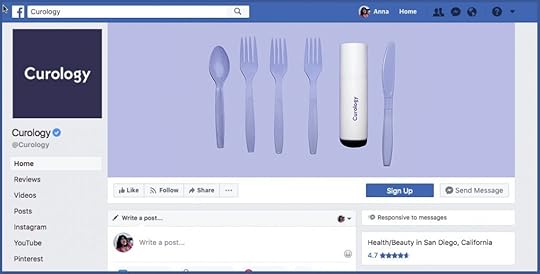
Step 2: Select “Info and Ads” at the bottom of the menu on the left of the page.
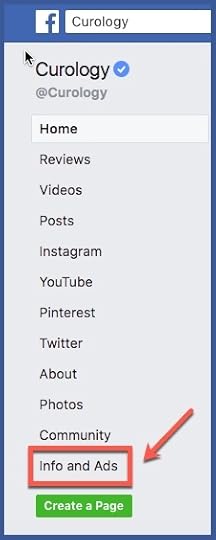
Step 3: Browse through the ads the page is actively running.
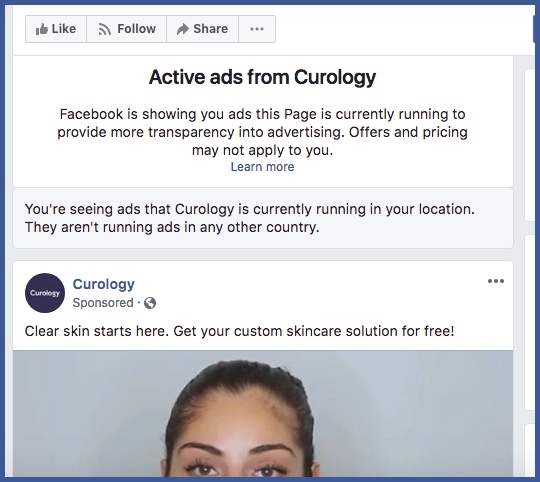
How to Use the Info and Ads Tool to Your Advantage
There are various elements you should look for with this valuable information at your fingertips. For example, you can keep an eye out for new products your competition teases in ads tested on a small audience. This allows you to see what they plan to eventually release to a larger audience. You can use this information to adjust your campaign promoting a rival product and distribute ads before or after your competitor.
You can also use Info and Ads to identify your competition’s key target locations. Depending on the type of campaign you’re running, for example, a campaign with a store visits objective, you need to target the right geographic audience to succeed. Take note of your competitor’s target locations and set your ads to target the same places. Your rival is likely targeting those areas because of past success.
Info and Ads can serve as an inspiration for new ad creative as well. Sometimes, we all get stuck in a rut when brainstorming for creative ideas. If your current creative isn’t making the cut, see what other businesses in your market are producing. It will give you ideas for your own campaign and allow you to see what you’re competing with.
Using Info and Ads, you can also see your competition’s offers, sales, and pricing. Users love a good deal. Make sure your competition isn’t offering something more tempting than yours. You can change the price of your products or services based on what you learn about rival offerings from the Info and Ads feature.
Finally, use Info and Ads to identify the ad formats your competition primarily uses. Facebook offers a variety of ad formats, such as Carousel ads, Canvas ads, and Dynamic ads. Some formats are more successful for promoting a certain product or service than others. For example, Carousel ads are best for showcasing a series of products whereas Canvas ads are better for demonstrating products in use. Sometimes it’s a challenge to determine which format will deliver the results you want. By researching the formats your rivals are using, you can see what works and what doesn’t before choosing the format to use for your own campaign.
Examples
Navigating to Curology’s Info and Ads section, you can see the company primarily uses video ad formats to promote its skincare products. The videos typically offer testimonials or demonstrate the product in use. As a competitor, you might decide to make a video-focused campaign similar to that of Curology. You may also identify a shortcoming in Curology’s ads to give your campaign an edge up. For instance, Curology’s ads appear to primarily focus on women’s use of the product. You could make your campaign more inclusive of all genders.
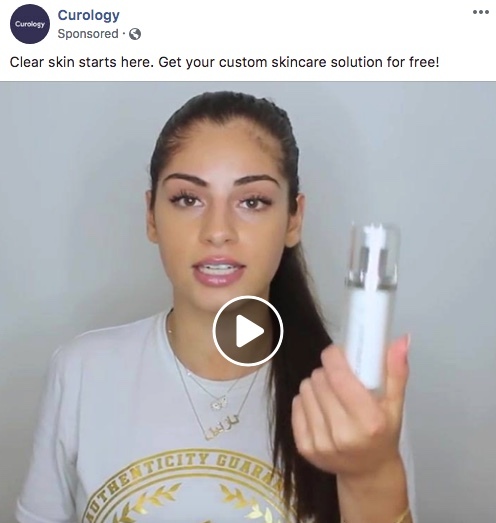
If you go to Nike’s Info and Ads section, you’ll notice that, in addition to video ads that showcase the company’s shoes, there are also various “Shop Now” ads that focus on the back-to-school season. If you’re a competing sportswear brand, you may use this insight to inform your own back-to-school campaign, trying different ad formats that could be more captivating than the ones Nike is producing.
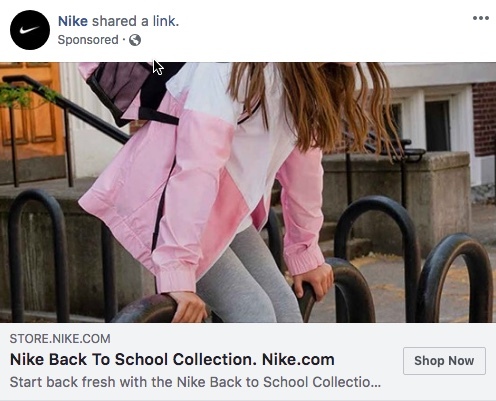
Info and Ads Is a Friend, Not a Foe
Yes, Facebook introduced the Info and Ads feature to keep advertisers accountable and transparent on the platform. But you shouldn’t interpret it as a form of intimidation. Use it to both build trust with your audience and keep tabs on your competition. The result will be more polished campaigns that have the extra boost you need to rise above your rivals.
The post Use Facebook’s Info and Ads Feature to Improve Ad Campaigns appeared first on AdvertiseMint.
August 8, 2018
3 Effective Ways to Collect Leads Using a Mobile Lead Generation Strategy
Stefan Des

The mobile technology industry grows by leaps and bounds. By the second quarter of 2018, 51.89 percent of global internet traffic originated from mobile devices, such as smartphones and tablets.
The statistics get better. By the end of July 2018, Global population of internet users stands at 4.1 billion, 3.3 billion of which are social media users. The statistics show that your audience is on social media, but you may wonder how you can generate leads from mobile and social media platforms. Here, you will learn how to use three social media ads to generate more leads for your business.

1. Facebook Lead Ads
Facebook has a huge potential for lead generation. As of Q2 2018, Facebook monthly active users (MAUs) stand at 2.23 billion. Out of this population, 1.74 are mobile monthly active users (MAUs). Additionally, 53 percent (more than half) of United States residents severally use Facebook in a day. Of all the social media platforms, Facebook is the most preferred by marketers, according to research by Statista.
With Facebook’s popularity among users combined with its Lead Generation ad, you can easily collect inexpensive leads from Facebook’s platform. Here’s how the ad works: Facebook will show your ad, which you can create in Ads Manager using the lead generation objective, to users on their mobile devices. When users click on the ad, they will see a pre-filled form containing their information, such as name and email, acquired from their Facebook profiles. Users can instantly become leads by clicking the submit button, no extra steps necessary.

The benefits Facebook Lead ads provide are undeniable:
The user does not have to the fill information manually, increasing the user’s likelihood of finishing the form and converting.
All activity takes place on the Facebook platform—users won’t be redirected to a slow-loading website not optimized for mobile, increasing their likelihood of converting.
You can store your leads in Business Manager and download the CSV file when needed.
You can later use your leads for ad targeting.
2. Instant Articles CTA Units
Facebook’s Instant Articles is a mobile publishing platform that allows you to share your articles and blogs to Facebook users. Articles published through Instant Articles load 10 times faster than a normal mobile web article. They also receive 20 percent more clicks and a higher number of reads.
Other than creating a mobile-friendly article for Facebook users, you can also use the Instant Articles platform to generate leads. You simply need to use Instant Articles’ CTA units. When users click on an article from Facebook, the article will open within the Facebook app. As users read the article, they will spot a CTA button that encourages them to take a desired action. To acquire leads, you can use the Sign Up button, which allows users to seamlessly sign up for your newsletter.
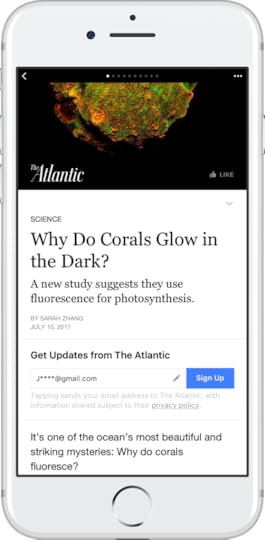
How to Sign Up for Instant Articles
Step 1: Sign up for Instant Articles on Facebook and fill the required information.
Step 2: Go to “configuration” in publishing tools and select “styles.”
Step 3: Choose the articles you want to import to Facebook and convert them into Instant Articles. To do this, you can use the Instant Articles for WordPress plugin, the Instant Articles API, or the RSS Feed.
Step 4: Connect your website to convert your articles. Go to “Configuration” in “Publishing tools” and click “Connect your site.” If you are using the WordPress plugin, add your URL. If you’re using the RSS feed or API, add a piece of code to the header of your website’s HTML.
You are required to submit 10 articles for review and approval. Because only approved articles are published on the platform, make sure the articles comply with the instructions on the submission checklist.
Step 5: Submit your articles for review. Click on “Configuration” and click “submit.” The review may take 3 to 5 business days.
Once your articles have been approved, you can share them on your Facebook pages. To get better results, contact your leads as soon as they sign up. A welcome email is appropriate.
3. LinkedIn Lead Gen Forms
The LinkedIn Lead Generation form helps you seamlessly collect quality leads from ads on LinkedIn with a pre-filled form. You can use the forms with sponsored InMail and sponsored content such as a link, image, or webpage update.
LinkedIn Lead Gen forms come with pre-filled user information taken from users’ LinkedIn profiles. With the form, you can collect users’ professional information, such as place of work, position, and the field of study, in just a few clicks.
With LinkedIn, 80 percent of engagements with sponsored content occur on mobile devices, and 57 percent of LinkedIn users visit using a mobile device. This makes the LinkedIn Lead Generation form an effective way of generating quality B2B leads for your business. If you’re not convinced, look at Bynder, a software company, that used the lead gen form to increase leads from sponsored content by 400 percent, achieving a 20 percent conversion rate.
You can also use the form to track your campaigns’ cost per lead and the number of leads you are getting from a professional audience segment. You can download your leads from Campaign Manager or integrate with your favorite marketing automation or CRM tool.
To optimize your Lead Gen Campaign for better results, make sure the images and copy are relevant, verify that your messaging matches your call to action, make your form concise, and do not include fields that require manual input.
To Gain Leads, Optimize for Mobile
Evidently, mobile use is increasing. If you want to increase leads on social media, you have to ensure that your methods are optimized for mobile because your users will most likely access your lead forms using a smartphone or a tablet. To increase leads on social media, use Facebook’s Lead Ad, Instant Articles’ CTA button, and LinkedIn’s Lead Gen forms. Use one strategy at a time so you can more accurately measure performance.
A social media advertising and marketing automation enthusiast, Stefan Des is the CEO and co-founder of LeadsBridge, a suite of automation tools for Facebook advertisers or for those working in a company for Facebook ads.
The post 3 Effective Ways to Collect Leads Using a Mobile Lead Generation Strategy appeared first on AdvertiseMint.



